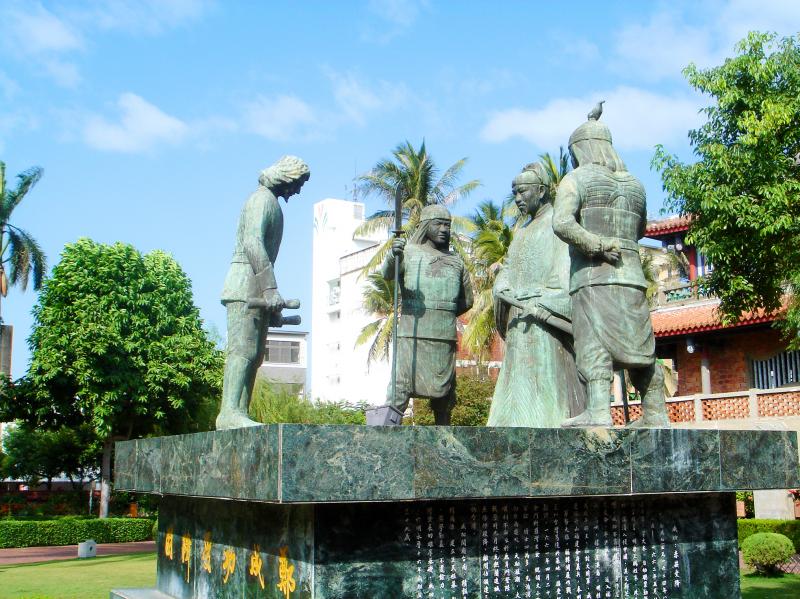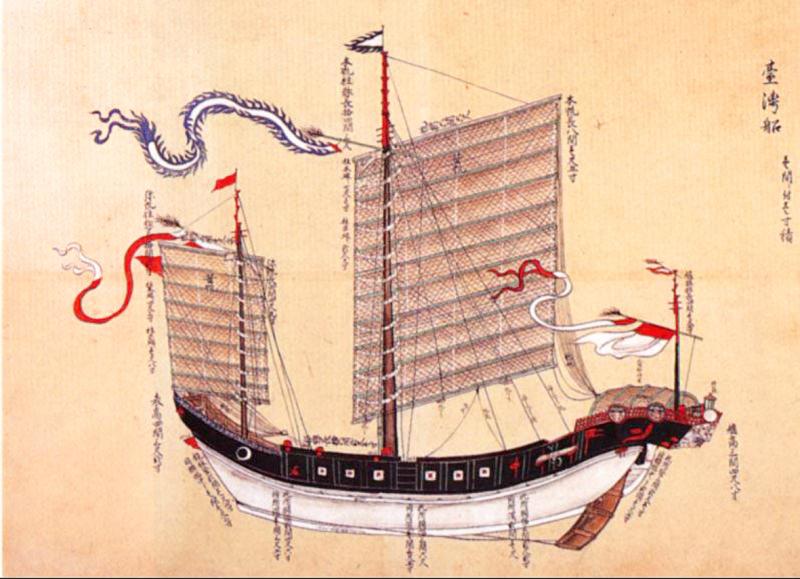Jan. 25 to Jan. 30
It was the beginning of the end when German sergeant Hans Jurgen Radis walked out of the Dutch-controlled Fort Zeelandia and surrendered to the besieging army of Cheng Cheng-kung (鄭成功, also known as Koxinga). The Dutch had already been trapped in the fort for nine months, and they were sick, hungry and in despair.
After one defection during the early days of the siege, Dutch commander Frederick Coyett set up checkpoints around the fort’s perimeter, in what is today’s Tainan. Radis told his bunkmate he was going hunting, but by the time they realized where he was headed, it was too late.

Photos courtesy of Wikimedia Commons
Tonio Andrade writes in How Taiwan Became Chinese that “Radis directed Cheng’s attention to a redoubt located on a hill above Fort Zeelandia. If Cheng could take it, he would be able to shoot directly into the company’s defenses and Zeelandia would be his.”
Cheng began constructing batteries for the operation, and Radis was seen at the fields providing his expertise. The Dutch could do nothing but watch.
On Jan. 25, 1662, Cheng rallied his troops for the final offensive and bombardment. Vastly overpowered, the Dutch blew up the fort and after discussing the matter, decided to surrender, ending their 38-year presence in Taiwan.

Photo courtesy of Wikimedia Commons
UNEASY RELATIONS
Just two decades after the Dutch established their presence in Taiwan in 1624, the Manchu armies had taken the Ming Dynasty capital of Beijing and been pushing southward against remaining Ming loyalists. Cheng was one of those opposed to the Manchus and their subsequent Qing Dynasty, and he camped in his stronghold of Xiamen, directly opposite Taiwan.
Cheng’s relations with the Dutch in Taiwan were cordial at first. Andrade writes that although Cheng would periodically request medical help from the Dutch, there remained deep distrust between the two parties. Some suspected that Cheng was eyeing Taiwan as a base in case he was driven from China. However, the relationship would grow rocky as Cheng began asserting that Taiwan’s Han inhabitants were under his jurisdiction, and blockaded trade between China and Taiwan.

Photo courtesy of Wikimedia Commons
A disastrous attempt to take Nanjing in 1659 left Cheng’s “prestige and organization shattered,” Andrade writes. The Qing threatened to execute anyone who dared trade with him, and were able to disrupt his business networks through a defector. Meanwhile, other centers of Ming loyalism were collapsing, allowing the Qing to focus more on Cheng.
Cheng repelled the first Qing offensive on Xiamen, but he needed new options.
Enter Ho Ting-pin (何廷斌, some sources show him as Ho Pin), who was a wily character. He could speak Dutch and was wealthy and well-connected; his brethren described him as a man with a “greedy appetite and “bottomless stomach.” Ho was the go-to guy when the Dutch needed to communicate with Cheng.
However, in 1659, Ho was caught cheating in a tax-farming auction and later discovered to be illegally collecting tolls from Chinese ships leaving Taiwan. The second offense was serious because it led to diminished trade, as captains were unwilling to pay. Furthermore, the Dutch found that the money was being funnelled to Cheng. Ho fled to Xiamen with his family, leaving a huge amount of debt in Taiwan.
But most importantly, he gave Cheng a map of Taiwan and told him of its riches. Two years later, Cheng announced that Taiwan was a “vast fertile land with revenues of several hundred thousand taels per year.”
“If we concentrate our skilled people there we could easily build ships and make weapons. Of late it has been occupied by the red-haired barbarians, but they have less than a thousand people in their fortress. We could capture it without lifting a hand. I want to conquer Taiwan and use it as a base.”
ASSAULT ON ZEELANDIA
In Taiwan, rumors had swirled of Cheng’s imminent invasion for over a year. On April 30, 1661, the Dutch spotted Cheng’s fleet heading toward them, while Taiwan’s Han inhabitants rushed to help the troops disembark.
The Dutch attempted to slow Cheng’s landing, hoping for the same success they enjoyed when they routed the much larger Kuo Huai-yi (郭懷一) rebels in 1652. But these weren’t angry peasants: they were battle-hardened soldiers.
Cheng’s army quickly took Fort Provintia, and for the next few days Aboriginal chiefs from the area came and pledged their allegiance. The Dutch could do nothing but hold out in Fort Zeelandia, which had powerful walls that withstood Cheng’s cannons.
The siege went on for months, and when 700 soldiers arrived from Batavia to relieve the Dutch, Cheng turned his anger toward Ho, who had told him that the battle would be easy and food was plentiful in Taiwan. In reality, there was barely anything to eat, and Cheng’s men had to find land to farm, which led to countless clashes with Aborigines. Ho “was stripped of his honors” and sent to “live in a small thatched hut, with orders to never show his face again,” Andrade writes. Cheng’s men routed the reinforcements, and the situation in the fortress became increasingly desperate, as the Dutch tried to unsuccessfully ally with the Qing.
Initially Cheng was not planning to launch a final attack until the spring of 1662, but heard that the Dutch had successfully contacted the Qing and formed an alliance. Whether this was true or not, Cheng felt that he had to act immediately.
Radis appeared at just the right time. While Coyett squarely blames the fall of Fort Zeelandia on the defector, some argue that the experienced Cheng had already known about the redoubt.
Nevertheless, Radis’s familiarity with the fort and advanced artillery knowledge did play a part, as it was his European-style battery that proved to be the most devastating during the bombardment. The Dutch discussed holding out and waiting for reinforcements, but ultimately walked out holding a white flag.
Taiwan in Time, a column about Taiwan’s history that is published every Sunday, spotlights important or interesting events around the nation that either have anniversaries this week or are tied to current events.

This month the government ordered a one-year block of Xiaohongshu (小紅書) or Rednote, a Chinese social media platform with more than 3 million users in Taiwan. The government pointed to widespread fraud activity on the platform, along with cybersecurity failures. Officials said that they had reached out to the company and asked it to change. However, they received no response. The pro-China parties, the Chinese Nationalist Party (KMT) and Taiwan People’s Party (TPP), immediately swung into action, denouncing the ban as an attack on free speech. This “free speech” claim was then echoed by the People’s Republic of China (PRC),

Exceptions to the rule are sometimes revealing. For a brief few years, there was an emerging ideological split between the Democratic Progressive Party (DPP) and Chinese Nationalist Party (KMT) that appeared to be pushing the DPP in a direction that would be considered more liberal, and the KMT more conservative. In the previous column, “The KMT-DPP’s bureaucrat-led developmental state” (Dec. 11, page 12), we examined how Taiwan’s democratic system developed, and how both the two main parties largely accepted a similar consensus on how Taiwan should be run domestically and did not split along the left-right lines more familiar in

Most heroes are remembered for the battles they fought. Taiwan’s Black Bat Squadron is remembered for flying into Chinese airspace 838 times between 1953 and 1967, and for the 148 men whose sacrifice bought the intelligence that kept Taiwan secure. Two-thirds of the squadron died carrying out missions most people wouldn’t learn about for another 40 years. The squadron lost 15 aircraft and 148 crew members over those 14 years, making it the deadliest unit in Taiwan’s military history by casualty rate. They flew at night, often at low altitudes, straight into some of the most heavily defended airspace in Asia.

Many people in Taiwan first learned about universal basic income (UBI) — the idea that the government should provide regular, no-strings-attached payments to each citizen — in 2019. While seeking the Democratic nomination for the 2020 US presidential election, Andrew Yang, a politician of Taiwanese descent, said that, if elected, he’d institute a UBI of US$1,000 per month to “get the economic boot off of people’s throats, allowing them to lift their heads up, breathe, and get excited for the future.” His campaign petered out, but the concept of UBI hasn’t gone away. Throughout the industrialized world, there are fears that